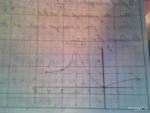Hey guys,
I have a couple of questions about this problem set I've been working on. I'm doubting some of my answers and I'd appreciate some help.
Question:
As for 2, for f ' (x), I got:
f(2^(1/3)) = 4.74.
But I was puzzled when I found out that no inflection point exists when I assessed f''(x)=0. Did I miscalculate anything up to this point?
Thanks in advance.
I have a couple of questions about this problem set I've been working on. I'm doubting some of my answers and I'd appreciate some help.
Question:
For 1, I simply calculated f'(x)=0 and f'(x) = DNE. Which gave me f(0)=0 and x=2 as the critical points. Then when determining concavity via f''(x)=0 and f''(x)= DNE, I got f''(x)=DNE at x=2 (again). How would I go about assessing this question? What feature is x=2 supposed to represent. Moreover, should I confirm my answers with the first and second derivative tests, or is there a different test I should be using?For \(\displaystyle f(x)\, =\, \dfrac{x^2}{(x\, -\, 2)^2},\) give the intervals of increase and decrease, identify any local extrema, give the intervals where concave up and concave down, and the coordinates of any points of inflection. Identify any asymptotes and sketch the curve.
For \(\displaystyle f(x)\, =\, 3x^{\frac{2}{3}}\, -\, x,\) give the intervals of increase and decrease, identify any local extrema, give the intervals where concave up and concave down, and the coordinates of any points of inflection. Identify any asymptotes and sketch the curve.
As for 2, for f ' (x), I got:
f(2^(1/3)) = 4.74.
But I was puzzled when I found out that no inflection point exists when I assessed f''(x)=0. Did I miscalculate anything up to this point?
Thanks in advance.
Last edited by a moderator:

